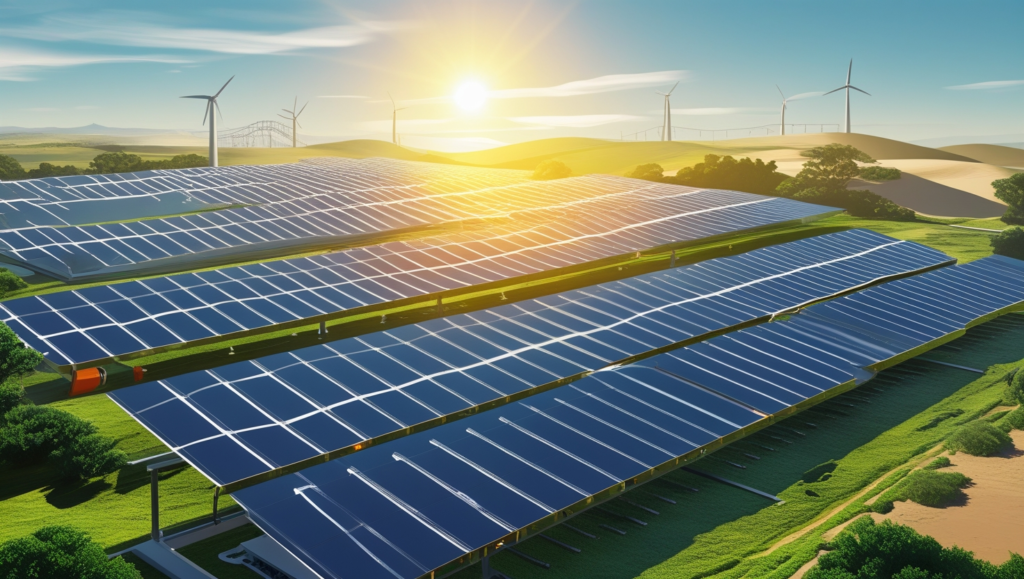Solar energy is derived from the sun, a star that has been burning for billions of years and is expected to continue for billions more. Unlike fossil fuels, which are finite and depleting, solar energy is virtually inexhaustible on a human timescale. The sun emits an immense amount of energy daily—far more than humanity could ever consume in a day.
Here’s why solar energy is considered a sustainable and enduring resource:
Daily Abundance: The Earth receives about 173,000 terawatts of solar energy each second. This amount is thousands of times greater than the global energy demand, making it a practically limitless resource if harnessed efficiently.
Longevity of the Sun: The sun is in its middle life stage, with approximately 5 billion years remaining before it exhausts its hydrogen fuel. This timeline ensures that solar energy will remain available for countless generations.
The Longevity of the Sun
The sun, our solar system’s life-giving powerhouse, generates energy through a process called nuclear fusion. This phenomenon involves the fusion of hydrogen atoms into helium, releasing a staggering amount of energy in the form of light and heat.
Currently, the sun is about 4.6 billion years old, positioned in the stable phase of its lifecycle. According to scientific projections, it has enough hydrogen fuel to sustain this fusion process for an estimated 5 billion more years. For perspective, that’s nearly 50 million times longer than a human lifespan, making solar energy effectively limitless in our lifetimes and far beyond.
From a practical standpoint, the sun’s longevity provides humanity with a virtually eternal source of clean, renewable energy. Unlike fossil fuels, which are finite and depleting, solar energy offers an enduring solution to global energy demands. Its reliability ensures that as long as the sun exists, we can harness its power to drive innovation and support sustainable living.
This remarkable longevity also underscores solar energy’s role as a cornerstone of renewable energy strategies, enabling societies to transition away from unsustainable resources and secure a cleaner future.

Why Solar Energy Is Renewable
Solar energy is one of the most abundant and sustainable resources available to humanity. Its classification as a renewable energy source is based on several compelling reasons:
Unlimited Supply
The sun emits an enormous amount of energy every second, far more than humanity could ever consume. Capturing sunlight through solar panels does not diminish or affect the sun’s output in any way. This makes solar energy an inexhaustible resource for as long as the sun continues to shine, which, as scientists predict, will be billions of years.
Sustainable Conversion
Solar panels harness sunlight and convert it into electricity using photovoltaic cells. This process is entirely sustainable, as it does not release greenhouse gases, produce harmful emissions, or deplete natural resources. Unlike fossil fuels, which require extraction and combustion, solar energy is harvested without causing significant environmental harm.
Global Availability
One of the greatest advantages of solar energy is its universal accessibility. Every region on Earth receives sunlight, although the intensity and duration may vary depending on location and season. This widespread availability ensures that solar energy can be harnessed in diverse environments, from urban rooftops to remote off-grid locations.
Solar energy’s renewability lies not only in its endless supply but also in the environmentally friendly way it is harvested and utilized. As long as the sun continues to illuminate our planet, solar energy will remain a dependable and renewable power source, offering a sustainable alternative to finite and polluting energy options.
Factors That Could Affect Solar Energy Usage
Although the sun’s energy is abundant and virtually limitless, several practical challenges could influence the efficiency and scalability of solar power utilization. Here are the key factors that may shape the future of solar energy:
1. Solar Panel Efficiency
The efficiency of solar panels is critical to maximizing the potential of solar energy. Currently, most panels convert only 15% to 22% of sunlight into electricity. While this is sufficient for many applications, increasing efficiency is essential to meet growing global energy demands.
Emerging technologies, such as perovskite solar cells and organic photovoltaics, show great promise in enhancing efficiency. These advancements could revolutionize solar panel design, making them more effective and cost-efficient.
2. Finite Resources for Manufacturing
The production of solar panels relies on finite materials, including silicon, silver, and certain rare earth metals. As demand for solar energy grows, these materials may become scarcer, driving up costs and limiting production.
To address this, researchers are exploring alternative materials and more sustainable manufacturing practices. Additionally, advancements in recycling technologies can recover valuable components from old panels, reducing the reliance on virgin resources.
3. Geographical and Climatic Challenges
Solar energy generation depends heavily on sunlight availability, which varies by region and weather conditions. Areas with frequent cloud cover or shorter daylight hours may struggle to generate consistent power.
Energy storage solutions, such as solar batteries, are crucial for overcoming these challenges. By storing excess energy produced during sunny periods, batteries ensure a reliable power supply during cloudy days or nighttime.
4. Infrastructure and Grid Integration
The widespread adoption of solar energy requires substantial upgrades to existing energy infrastructure. Many grids are not designed to handle the variability of renewable energy sources, which can lead to inefficiencies and reliability issues.
Innovations like smart grids and decentralized energy systems can enhance the integration of solar power into the grid. These technologies allow for more flexible and efficient distribution, ensuring a stable energy supply even as solar adoption increases.

Overcoming the Challenges
While these factors present real obstacles, ongoing advancements in technology, recycling, and infrastructure are paving the way for a more robust solar energy future. Addressing these issues will enable us to fully realize the potential of this clean,
As global energy demands grow alongside population and industrialization, solar energy is emerging as a cornerstone of sustainable power generation. With continuous technological improvements and strategic investments, solar power has the potential to meet a substantial portion of global electricity needs. Here’s how solar energy is gearing up to tackle future challenges:
High-Efficiency Panels
The efficiency of solar panels is a key factor in scaling solar energy to meet rising demands. Current advancements are pushing the boundaries of photovoltaic technology, with researchers aiming to develop panels that achieve efficiencies exceeding 30%.
- Perovskite Solar Cells: These next-generation materials are lightweight, cost-effective, and capable of significantly improving energy conversion rates.
- Bifacial Panels: These panels capture sunlight on both sides, increasing energy output without requiring additional space.
As panel efficiencies improve, more energy can be harnessed from smaller installations, making solar power accessible in space-constrained areas.
Affordable Storage Solutions
One of the primary challenges of solar energy is its intermittent nature. Energy storage systems are critical for ensuring a steady supply of electricity, especially during nighttime or cloudy days.
- Lithium-Ion Batteries: Already popular in residential and commercial systems, these batteries are becoming more affordable and efficient.
- Solid-State Batteries: A promising technology under development, these batteries offer higher energy densities, faster charging, and longer lifespans.
- Grid-Scale Storage: Large-scale storage solutions are being deployed to support utility-scale solar farms, enabling them to supply power consistently.
With improved storage technologies, solar energy can shift from a supplemental power source to a primary one.
Solar Farms for Mass Energy Production
Utility-scale solar farms are transforming the energy landscape by generating power for entire communities and regions.
- Land-Based Solar Farms: Sprawling installations in sunny regions provide massive amounts of renewable energy, reducing dependence on fossil fuels.
- Floating Solar Farms: Built on bodies of water, these innovative systems optimize land use while increasing solar capacity.
- Hybrid Systems: Combining solar farms with wind and hydroelectric power creates a balanced and reliable energy mix.
By expanding solar farms and integrating them with advanced grids, we can achieve significant reductions in greenhouse gas emissions while meeting growing energy demands.
The Road Ahead
While challenges remain—such as scaling up manufacturing and improving grid infrastructure—the trajectory of solar energy is undeniably promising. With breakthroughs in efficiency, storage, and large-scale deployment, solar energy has the potential to power a sustainable future for generations to come. By embracing these innovations, you can contribute to a greener, more resilient energy future.
The Future of Solar Energy
Solar energy is more than just a sustainable power source; it represents a shift toward a cleaner, greener future. Governments, businesses, and individuals are increasingly investing in solar technology to reduce carbon emissions and combat climate change.
In addition to its environmental benefits, solar energy offers economic advantages, such as reduced energy costs and job creation in the renewable energy sector. With continued innovation and global support, solar energy will remain a cornerstone of the energy landscape for generations to come.

Conclusion: A Resource That Lasts Forever
Solar energy stands out as one of the most sustainable and abundant solutions to the world’s energy needs. With the sun expected to shine for billions of years, solar energy is essentially inexhaustible on a human timescale. While challenges such as material availability, panel efficiency, and grid infrastructure remain, ongoing innovations and investments promise to overcome these hurdles, securing solar power’s place as a cornerstone of global energy systems.
By choosing solar energy today, you’re not just reducing your carbon footprint but also paving the way for a cleaner, more resilient future. Harnessing the power of the sun means embracing an energy source that is both infinite and environmentally friendly. Join the movement toward sustainable living and take a step toward a brighter tomorrow.










2 thoughts on “Will Solar Energy Ever Run Out?”
Comments are closed.